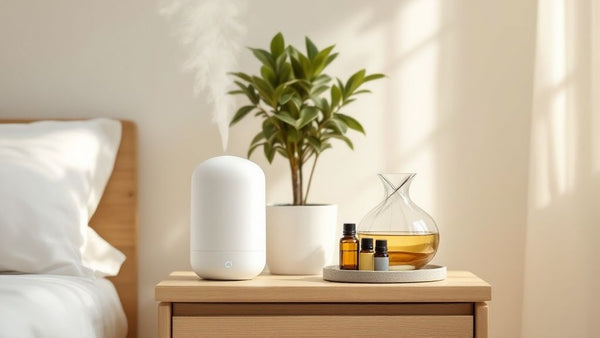Difference Between Humidifier and Diffuser: Which Is Right for You?
Sep 04, 2025
At their core, the biggest difference between a humidifier and a diffuser comes down to one thing: purpose.
A humidifier's main job is to add moisture to the air, plain and simple. Think of it as a workhorse for battling dryness. A diffuser, on the other hand, is all about dispersing essential oils for aromatherapy and creating an atmosphere. While some newer gadgets try to do both, their original designs were created for these very different needs.
Understanding the Primary Purpose
Even though they both puff out a visible mist, what that mist is meant to do couldn't be more different.
A humidifier is a functional appliance, almost like a piece of health equipment. Its goal is to raise the relative humidity in a room. This is a game-changer in dry climates or during those long winter months when your heating system zaps every last drop of moisture from the air, leaving you with dry skin and scratchy throats.
In contrast, a diffuser is more of a wellness and lifestyle device. Its whole reason for being is to break down essential oils into tiny micro-particles and send them floating through your space. This fills the room with fragrance and unlocks the therapeutic benefits of the oils. That little bit of water vapor you see? It's just a side effect of the process, not the main event.

Getting this distinction right is the first step in figuring out which one actually belongs in your home.
Humidifier vs Diffuser At a Glance
To make it even clearer, let's break down the key differences side-by-side. This quick comparison shows how their distinct goals influence everything from their design to their benefits.
| Feature | Humidifier | Diffuser |
|---|---|---|
| Primary Goal | Increase air moisture (humidity). | Disperse essential oil aromas. |
| Main Benefit | Health (e.g., relieves dry skin, sinuses). | Wellness (e.g., relaxation, mood-setting). |
| Water Capacity | Large (often 1 gallon or more). | Small (typically under 500 mL). |
| Area Coverage | Designed for entire rooms or large spaces. | Localized scent coverage. |
As you can see, one is built for large-scale environmental control, while the other is designed for a more personal, sensory experience.
How Humidifiers Improve Air Quality and Health
At its core, a humidifier is a home health appliance. Its one and only job is to methodically add moisture back into the air, creating a more comfortable and healthier indoor environment. While a diffuser is all about scent, a humidifier is engineered specifically to fight the effects of dry air—something that’s especially critical during winter months when our heating systems are working overtime, or if you live in a naturally arid climate.
Keeping your home’s humidity in the sweet spot, which is ideally between 30% and 50%, makes a world of difference. When the air is too dry, you feel it: itchy skin, chapped lips, and irritated sinuses become the norm. By releasing a fine mist, humidifiers restore that much-needed moisture, offering real relief from those symptoms and even helping to ease congestion when you’re down with a cold.
Types of Humidifiers and Their Benefits
Humidifiers all add moisture to the air, but they get there using a few different technologies. The most common types you’ll run into are:
- Ultrasonic Humidifiers: These use high-frequency vibrations to create a super-fine, cool mist. They're known for being whisper-quiet, which makes them a go-to choice for bedrooms.
- Evaporative Humidifiers: This type uses a fan to blow air through a wet wick or filter. These models are pretty smart—they're self-regulating because the air will only absorb as much moisture as it can physically hold.
- Steam Vaporizers: These little workhorses actually boil water to create a warm, soothing steam. A nice side benefit is that the boiling process kills off waterborne bacteria and germs before the mist ever hits your room.
By directly tackling air dryness, a humidifier does more than just soothe your sinuses—it can also protect your wooden furniture, flooring, and even musical instruments from cracking over time.
As more people recognize the downsides of dry air, these devices have become incredibly popular. In fact, portable humidifiers now make up about 64.5% of the market share, mostly because they’re affordable and can be placed exactly where you need them most, like a nursery or home office. With residential use accounting for 61.5% of the market, it’s obvious that homeowners are making air quality a priority. You can check out the latest humidifier market trends to see just how much of a household staple they’ve become.
The image below shows a perfect example of a modern humidifier built for home use.

You can see its larger water tank and straightforward controls are designed for long-lasting, continuous operation. It’s a clear signal that this is a functional health appliance, not just a decorative piece.
How Diffusers Enhance Your Home's Atmosphere
While a humidifier is all about adding moisture back into the air for your physical comfort, a diffuser is designed for something else entirely: enhancing your home's atmosphere through scent and aromatherapy. That’s the real key to understanding the difference. A diffuser's mission is to turn your space into a sanctuary of wellness and relaxation.
It works by breaking down essential oils into tiny micro-particles and dispersing them throughout a room. This process, usually handled by ultrasonic vibrations, fills your home with a pleasant, curated fragrance. The result is more than just a great-smelling space; it’s about creating a specific mood. Think calming lavender for the bedroom or an energizing citrus for your home office.
The Power of Aromatherapy
The wellness benefits tied to aromatherapy are a big deal. By dispersing specific essential oils, a diffuser can help dial down stress, lift your mood, or even sharpen your focus. This makes it a powerful tool for personalizing your environment. You can dive deeper into the many benefits of an essential oil diffuser and see just how different scents can impact your well-being.
A diffuser is less of a functional appliance and more of a lifestyle accessory. Its purpose is to deliver the therapeutic and aromatic properties of essential oils to create a better living environment.
This focus on wellness has carved out a huge market. In fact, the aromatherapy diffuser market is projected to hit around $1.5 billion with a compound annual growth rate of 12.1%. That kind of growth shows a real consumer desire for luxury and wellness products that do more than just manage air quality. You can find more insights on aromatherapy trends on accio.com.
The screenshot below shows an Airomatica diffuser, a perfect example of a device built for sophisticated scenting.

Its sleek design is meant to blend seamlessly into your decor, really highlighting its role in creating an atmosphere rather than just performing a utility function.
A Detailed Functional Breakdown
To really get the difference between a humidifier and a diffuser, we need to look past their basic functions and see how they’re actually built to work in the real world. A side-by-side look at their engineering shows some key distinctions in their design and operation that directly change how you’ll end up using them.
Core Purpose: Health vs. Wellness
The most fundamental difference really comes down to their intended purpose. A humidifier is a health appliance, plain and simple. It’s designed to fight the miserable effects of dry air by adding moisture back into your environment. Think of it as a direct solution for physical problems like dry skin, irritated sinuses, and nagging allergy symptoms.
A diffuser, on the other hand, is all about wellness and lifestyle. Its main job is to disperse essential oils for aromatherapy, helping you create a specific mood or sensory experience. While it does release a little moisture, that's just a side effect of its oil-delivery system.
The core operational difference is simple: one is built to move a large volume of water into the air, while the other is designed to delicately carry a small amount of oil. This single principle dictates every other design choice.
Operational Mechanism and Construction
This core purpose directly shapes how they’re made. Humidifiers are engineered to handle large amounts of water safely and efficiently, often running for hours at a time. Their internal parts, from the tank to the atomizer, are made from materials that can stand up to constant water exposure without breaking down.
Diffusers, however, are built with oil resistance in mind. Essential oils are powerful and can eat away at standard plastics over time. That’s why diffusers are made from specialized, oil-resistant polymers (like polypropylene) to prevent damage. To get a closer look at the mechanics, our guide on how an oil diffuser works breaks down the internal components that make aromatherapy possible.
Water Capacity and Coverage Area
A quick look at their water tanks tells you most of the story. Humidifiers have big reservoirs, often holding a gallon (3.78 liters) or more. This large capacity is what allows them to effectively humidify an entire room over many hours.
Diffusers have much smaller tanks, usually under 500 mL. Their goal isn’t to change a room's humidity but to provide a localized, on-and-off scent for a few hours. This difference in scale also reflects how people buy them. Humidifiers are seen as functional health devices, while diffusers are often purchased as lifestyle enhancers—in fact, you can see consumer trends for diffusers spike during gift-giving seasons.
Here’s a more detailed look at how their features stack up against each other.
Feature Breakdown: Humidifier vs. Diffuser
This table breaks down the technical and practical differences, showing you exactly what each device is built for.
| Specification | Humidifier | Diffuser |
|---|---|---|
| Primary Function | Increase ambient humidity | Disperse essential oils |
| Water Tank Capacity | Large (1-4 liters or more) | Small (100-500 mL) |
| Runtime | Long (8-24+ hours) | Short (3-6 hours) |
| Moisture Output | High | Minimal (byproduct) |
| Aromatherapy | Not recommended; oils can damage | Primary purpose |
| Construction | Water-resistant materials | Oil-resistant polymers (PP) |
| Best For | Dry climates, allergy relief | Mood setting, relaxation |
As you can see, every design choice—from the tank size to the materials used—is made to serve a completely different end goal.
Making the Right Choice for Your Situation
So, humidifier or diffuser? It really just boils down to what you're trying to accomplish. Are you looking for a practical health benefit, or is it all about creating a certain vibe in your home? One is a functional tool for your well-being, the other is all about atmospheric wellness.
This quick guide should clear things up.

As you can see, it's a pretty straightforward choice. If you need to add moisture back into the air, grab a humidifier. If it's all about aromatherapy and scent, a diffuser is what you're looking for.
When to Choose a Humidifier
A humidifier is your best bet when the goal is purely functional: getting more moisture into the air for your health and comfort.
You'll want a humidifier if you're:
- Dealing with a cough or cold: The added humidity is a game-changer for easing congestion and soothing a scratchy throat. It's especially great in a nursery or kid's room when someone is sick.
- Fighting back against dry air: Whether you're in an arid climate or just cranking the heat in winter, a humidifier restores moisture to stop dry skin, chapped lips, and irritated sinuses in their tracks.
- Trying to calm allergy symptoms: Maintaining the right humidity level can help keep airborne allergens from floating around and soothes inflamed nasal passages for anyone suffering from allergies.

Think of it as a small appliance that works hard to create a healthier breathing environment, like in this nursery setup.
When to Choose a Diffuser
On the flip side, a diffuser is all about enhancing your space through scent. It’s the perfect tool for setting a specific mood or creating a signature ambiance.
A diffuser is the way to go for:
- Creating a relaxing atmosphere: Think calming scents like lavender drifting through the bedroom to help you unwind and rest.
- Boosting focus and energy: An energizing citrus or mint oil in your home office can be just the thing to improve concentration and get you through the afternoon slump.
- Freshening your living space: Diffusers are fantastic for knocking out lingering odors and establishing a welcoming, signature scent for your home.
If you're ready to explore how to create that perfect vibe, check out our guide on choosing the best essential oils for your home scent.
Answering Your Humidifier and Diffuser Questions
Once you get a handle on the main differences, a few practical questions almost always pop up. To make sure you're using your new device safely and getting the most out of it, we've put together some straightforward answers to the most common queries.
Can I Put Essential Oils in a Regular Humidifier?
The short and firm answer here is no. This is a critical safety point. Standard humidifiers are built with plastics and internal parts designed to handle one thing: water. Essential oils are powerful, and their corrosive nature can actually degrade the tank and mechanisms, leading to malfunctions or even ruining the unit and voiding your warranty.
It's always best to stick to the manufacturer's guidelines. If you're set on getting both humidity and a lovely scent, look for a combination unit or a humidifier that includes a dedicated aromatherapy tray. These are specifically designed to handle oils without damaging the machine.
Is an Ultrasonic Diffuser an Effective Humidifier?
While it’s true that an ultrasonic diffuser releases a fine mist of water, it’s not an effective substitute for a humidifier. The water tanks on diffusers are tiny—usually holding less than 500 mL—and their moisture output is just a drop in the bucket compared to what a real humidifier can do.
Think of the moisture from a diffuser as a small bonus to its main job: aromatherapy. It simply won't release enough water into the air to provide the health benefits needed to combat dryness.
For real relief from dry skin, irritated sinuses, or allergy symptoms, a dedicated humidifier is the only way to go. A diffuser’s moisture output is just too low to make a meaningful difference in your home's air quality.
Which Device Is Better for Soothing Allergies?
For direct allergy relief, a humidifier is the clear winner. Dry air is a major irritant for nasal passages, making allergy symptoms feel so much worse. A humidifier adds that much-needed moisture back into the air, which helps soothe inflammation. It can also help reduce the amount of airborne allergens like dust and pet dander by making them heavier, so they fall out of the air.
While some essential oils like eucalyptus or peppermint used in a diffuser can offer temporary relief by clearing congestion, a humidifier gets to the root of the environmental problem—dryness—that often makes allergic reactions more intense.
How Often Should I Clean These Devices?
This is non-negotiable for both devices. Regular cleaning is absolutely essential to prevent mold and bacteria from growing and being dispersed into your air.
- Humidifiers: These need a good cleaning every one to three days, depending on how often you use them. Make sure to follow the manufacturer's instructions to the letter for safe operation.
- Diffusers: It's best to clean your diffuser after every few uses, or any time you decide to switch essential oils. This keeps the scents pure and ensures the device runs smoothly.
Ready to transform your home’s atmosphere with luxurious, hotel-inspired scents? Explore the world of sophisticated aromatherapy with Airomatica and find the perfect scent solution to elevate your space.



